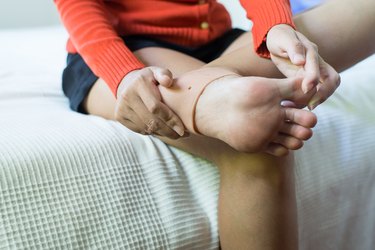
A bone spur is a bony growth that can appear along the edge of any bone. Also known as osteophytes, bone spurs do not always cause pain, as explained by Mayo Clinic.
However, when they form on joints that rub against each other, your foot or your spine, they can place added pressure on your nerves, resulting in pain and discomfort, especially when you exercise because you are putting more pressure on your bones.
Video of the Day
Video of the Day
Tip
If a bone spur is causing pain, it's best to avoid exercise until symptoms improve.
Read more: A Sore Heel After Running
Consider Underlying Conditions
Bone spurs can further complicate a condition because they most often are the result of another condition. For example, when your ligaments wear down due to osteoarthritis, the body attempts to repair itself by growing a bone spur.
Other conditions that may cause bone spurs include spondolysis or spinal stenosis, which refer to degeneration of the disks in your spine and arthritic changes. Plantar fasciitis, when your connective tissue in the heel and foot becomes irritated, also may cause bone spurs to develop, as explained by Cleveland Clinic.
These conditions can restrict your movement capabilities, which can make it more difficult to exercise and may necessitate choosing only low-impact activities for exercise, such as cycling, walking, swimming or using an elliptical machine.
Seek Medical Attention
If you experience nerve pain that may be related to a bone spur, see your physician. He may perform a physical examination and imaging scans to test for bone spurs. If you are diagnosed with a bone spur, ask your physician if it could be the result of complicating factors. Also ask if this should change the way you exercise.
For example, a bone spur in the knee that indicates osteoarthritis may mean you should re-examine high-impact activities like your weekly football league or sprints, which can place too much strain on your joints. Instead, try swimming or cycling, as recommended by the American Academy of Orthopaedic Surgeons.
Try Home Remedies
If you do experience a bone spur, it may be best to take a short rest period from exercise to relieve the pressure and inflammation on the bone spur area. Take one to two weeks off. During this time, take anti-inflammatory medications, if approved by your doctor, and ice the affected area three times a day for 10 to 15 minutes.
You may wish to perform gentle exercises to maintain flexibility. Warm up with a five-minute walk; then stretch your major muscle groups, paying special attention to where you experience the bone spur. This can help relieve the degree to which the bone spur presses on your nerve.
Read more: Back of Heel Burning Pain When Stretching
Exercise With Caution
Sometimes bone spurs can break off from the bone and travel to the lining of a joint. When these become embedded, you may experience locking of the joint with exercise, such as a knee or elbow locking.
This can be dangerous for your exercise routine because if your joint locks while lifting a weight, using a treadmill or on the playing field, you are at an increased risk for injury. If you experience this symptom, see your physician immediately to mitigate the problem.
Was this article helpful?
150 Characters Max
0/150
Thank you for sharing!
Thank you for your feedback!
Is this an emergency? If you are experiencing serious medical symptoms, please see the National Library of Medicine’s list of signs you need emergency medical attention or call 911.